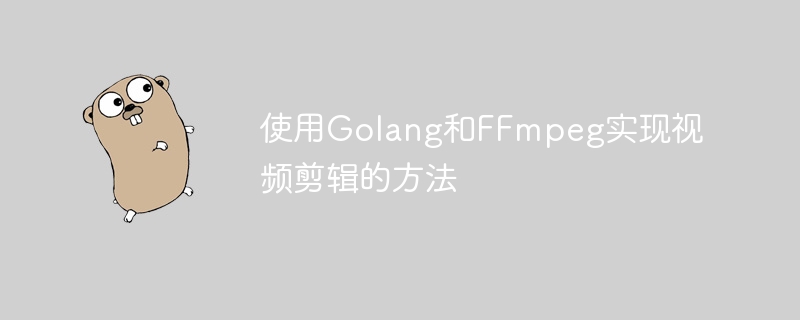
Golang と FFmpeg を使用してビデオ編集を実装する方法には、特定のコード サンプルが必要です
概要:
ビデオ編集は、ビデオの編集を通じて一般的なマルチメディア処理要件です。ビデオのトリミング、スプライス、カット、ウォーターマークの追加などの機能を実現できます。この記事では、Golang ライブラリと FFmpeg ライブラリを使用してビデオ編集を実装する方法を紹介し、具体的なコード例を示します。
ステップ 1: FFmpeg をインストールする
まず、FFmpeg をインストールする必要があります。 FFmpeg は、さまざまなプラットフォームで使用できるオープンソースのマルチメディア処理ライブラリです。具体的なインストール方法はFFmpeg公式サイト(https://ffmpeg.org/)をご覧ください。
インストールが完了したら、ターミナルまたはコマンド ラインで FFmpeg を直接呼び出せるように、FFmpeg 実行可能ファイルをシステム環境変数に追加する必要があります。
ステップ 2: Golang の FFmpeg ライブラリをダウンロードする
Golang の FFmpeg ライブラリは、FFmpeg 関数を呼び出すために使用される Go 言語ライブラリであり、このライブラリをプロジェクトに導入する必要があります。ライブラリは次のコマンドでダウンロードできます:
go get github.com/giorgisio/goav/avcodec
go get github.com/giorgisio/goav/avformat
go get github.com/giorgisio/goav / avutil
go get github.com/giorgisio/goav/swscale
ステップ 3: ビデオ クリッピングのコード実装
次は、Golang および FFmpeg ライブラリを使用してビデオ クリッピングを実装するサンプル コードです。
package main
import (
"fmt"
"os"
"strings"
"sync"
"time"
"github.com/giorgisio/goav/avcodec"
"github.com/giorgisio/goav/avformat"
)
func main() {
start := time.Now()
inputFileName := "input.mp4"
outputFileName := "output.mp4"
startTime := 10
duration := 20
// 初始化FFmpeg库
avformat.AvRegisterAll()
avcodec.AvcodecRegisterAll()
// 打开输入文件
inputFormatContext := avformat.AvformatAllocContext()
if avformat.AvformatOpenInput(&inputFormatContext, inputFileName, nil, nil) != 0 {
fmt.Println("Failed to open input file")
os.Exit(1)
}
// 找到输入文件中的流信息
if avformat.AvformatFindStreamInfo(inputFormatContext, nil) < 0 {
fmt.Println("Failed to find stream info")
os.Exit(1)
}
// 寻找视频流信息
var videoStreamIndex int
for i := 0; i < int(inputFormatContext.NbStreams()); i++ {
if inputFormatContext.Streams()[i].CodecParameters().CodecType() == avformat.AVMEDIA_TYPE_VIDEO {
videoStreamIndex = i
break
}
}
// 获取视频流的解码器上下文
videoCodecContext := inputFormatContext.Streams()[videoStreamIndex].Codec()
// 初始化解码器
videoCodec := avcodec.AvcodecFindDecoder(videoCodecContext.CodecId())
if videoCodec == nil {
fmt.Println("Unsupported codec")
os.Exit(1)
}
videoCodecContext.AvcodecOpen2(videoCodec, nil)
// 创建输出文件
outputFormatContext := avformat.AvformatAllocContext()
if avformat.AvformatAllocOutputContext2(&outputFormatContext, nil, "", outputFileName) != 0 {
fmt.Println("Failed to create output file")
os.Exit(1)
}
// 添加视频流到输出文件
outputVideoStream := outputFormatContext.AvformatNewStream(nil)
if outputVideoStream == nil {
fmt.Println("Failed to create output video stream")
os.Exit(1)
}
// 复制输入视频流的参数到输出视频流
outputVideoStream.SetCodecParameters(videoCodecContext.CodecParameters())
// 写入输出文件头
if avformat.AvformatWriteHeader(outputFormatContext, nil) != 0 {
fmt.Println("Failed to write output file header")
os.Exit(1)
}
// 读取和写入视频帧
packets := avformat.AvPacketAlloc()
frame := avutil.AvFrameAlloc()
frameCount := 0
for {
// 从输入文件中读取一个packet
if avformat.AvReadFrame(inputFormatContext, packets) < 0 {
break
}
// 判断是否为视频流的packet
if packets.StreamIndex() == videoStreamIndex {
// 解码packet
if avcodec.AvcodecSendPacket(videoCodecContext, packets) != 0 {
fmt.Println("Failed to send packet to decoder")
os.Exit(1)
}
for avcodec.AvcodecReceiveFrame(videoCodecContext, frame) == 0 {
// 判断当前帧是否在指定的时间范围内
currentTime := float64(frameCount) * avutil.AvQ2D(videoFormatContext.Streams()[videoStreamIndex].TimeBase())
if currentTime >= float64(startTime) && currentTime <= float64(startTime+duration) {
// 将剪辑好的帧写入输出文件
if avcodec.AvcodecSendFrame(outputCodecContext, frame) != 0 {
fmt.Println("Failed to send framed to encoder")
os.Exit(1)
}
for {
if avcodec.AvcodecReceivePacket(outputCodecContext, packets) != 0 {
break
}
// 将packet写入输出文件
avformat.AvWriteFrame(outputFormatContext, packets)
avcodec.AvPacketUnref(packets)
}
}
frameCount++
}
}
// 写入输出文件尾部
avformat.AvWriteTrailer(outputFormatContext)
// 释放资源
avutil.AvFrameFree(frame)
avformat.AvformatCloseInput(&inputFormatContext)
avformat.AvformatFreeContext(inputFormatContext)
avformat.AvformatFreeContext(outputFormatContext)
avcodec.AvcodecClose(videoCodecContext)
avcodec.AvcodecFreeContext(videoCodecContext)
fmt.Println("Video clipping completed in", time.Since(start))
}上記のコードはビデオ編集の基本的な機能を実装しています。最初に入力ファイルからビデオ ストリームのフレームを読み取り、フレーム時間を判断して保持する必要があるフレームを出力ファイルに書き込みます。 。 FFmpeg ライブラリによって提供される関数は、読み取り、デコード、エンコード、および書き込み操作に使用されます。
この例では 1 つのビデオ ストリームのみを編集します。複数のビデオ ストリームが関係する場合は、実際の状況に基づいて対応する修正を行う必要があることに注意してください。
結論:
この記事では、Golang と FFmpeg を使用してビデオ編集を実装する方法を紹介し、具体的なコード例を示します。読者は、自分のニーズに応じてコードを調整および拡張し、より複雑でパーソナライズされたビデオ編集機能を実現できます。同時に、公式 FFmpeg ドキュメントと Golang の FFmpeg ライブラリ ドキュメントを読んで、ビデオ編集について詳しく学ぶこともできます。
以上がGolang と FFmpeg を使用してビデオ編集を実装する方法の詳細内容です。詳細については、PHP 中国語 Web サイトの他の関連記事を参照してください。